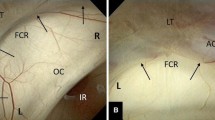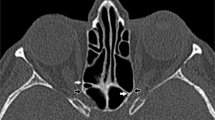Abstract
Background
The relationship between the optic apparatus and the skull base is important during approaches near the sella turcica. One relationship that dictates which approach is taken is whether the optic chiasm is prefixed or postfixed or in a “normal” location, (centered over the diaphragma sella). The relationship between the position of the chiasm and the angulation of the pituitary stalk has not been investigated.
Methods
Forty adult cadavers without intracranial pathology were dissected and parasagitally hemisected lateral to the sella turcica. The angulations between the pre- and postfixed and normal chiasm and the pituitary stalk were evaluated under magnification. Additionally, 50 MRIs performed among patients evaluating headache were analyzed for these relationships.
Results
For cadavers, the chiasm was prefixed in 7.5 % (n = 3), normal in 85 % (n = 34), and postfixed in 7.5 % (n = 3). On imaging, the chiasm was prefixed in 4 % (n = 2), normal in 88 % (n = 44), and postfixed in 8 % (n = 4). For all, the relation between the type of chiasm and the pituitary stalk was more often (p < 0.05) 90° or greater for prefixed chiasmata and acute angles for normal or postfixed chiasmata.
Conclusions
These data may assist skull base surgeons when approaching pathology near the optic chiasm and pituitary stalk.






Similar content being viewed by others
Abbreviations
- ICA:
-
Internal carotid artery
- MR:
-
Magnetic resonance
- MRIs:
-
Magnetic resonance images
References
Andrews TJ, Halpern SD, Purves D (1997) Correlated size variations in human visual cortex, lateral geniculate nucleus, and optic tract. J Neurosci 17:2859–2868
Bergland RM, Ray BS, Torack RM (1968) Anatomical variations in the pituitary gland and adjacent structures in 225 human autopsy cases. J Neurosurg 28:93–99
Doyle AJ (1990) Optic chiasm position on MR images. AJNR Am J Neuroradiol 11:553–555
Gillig PM, Sanders RD (2009) Cranial nerve II: vision. Psychiatry (Edgmont) 6:32–37
Gulsen S, Dinc AH, Unal M, Canturk N, Altinors N (2010) Characterization of the anatomic location of the pituitary stalk and its relationship to the dorsum sellae, tuberculum sellae and chiasmatic cistern. J Korean Neurosurg Soc 47:169–173
Hofer S, Karaus A, Frahm J (2010) Reconstruction and dissection of the entire human visual pathway using diffusion tensor MRI. Front Neuroanat 4:15
Jeffery G (2001) Architecture of the optic chiasm and the mechanisms that sculpt its development. Physiol Rev 81:1393–1414
O’Connell JE (1973) The anatomy of the optic chiasma and heteronymous hemianopia. J Neurol Neurosurg Psychiatry 36:710–723
Reese BE (2011) Development of the retina and optic pathway. Vision Res 51:613–632
Renn WH, Rhoton AL Jr (1975) Microsurgical anatomy of the sellar region. J Neurosurg 43:288–298
Rhoton AL Jr (2002) The sellar region. Neurosurgery 51:S335–S374
Rhoton AL Jr, Yamamoto I, Peace DA (1981) Microsurgery of the third ventricle: part 2. Operative approaches. Neurosurgery 8:357–373
Schaeffer J (1924) Some points in the regional anatomy of the optic pathway, with especial reference to tumors of the hypophysis cerebri and resulting ocular changes. Anat Rec 28:243–279
Schick U, Hassler W (2005) Surgical management of tuberculum sellae meningiomas: involvement of the optic canal and visual outcome. J Neurol Neurosurg Psychiatry 76:977–983
Conflicts of interest
None
Funding received for this study
None
Author information
Authors and Affiliations
Corresponding author
Rights and permissions
About this article
Cite this article
Griessenauer, C.J., Raborn, J., Mortazavi, M.M. et al. Relationship between the pituitary stalk angle in prefixed, normal, and postfixed optic chiasmata: an anatomic study with microsurgical application. Acta Neurochir 156, 147–151 (2014). https://doi.org/10.1007/s00701-013-1944-1
Received:
Accepted:
Published:
Issue Date:
DOI: https://doi.org/10.1007/s00701-013-1944-1




